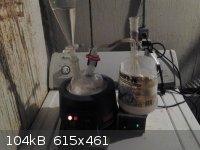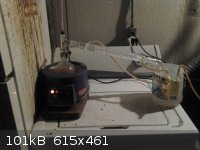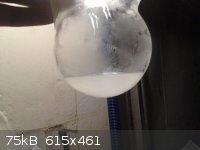bromobagel
Harmless

Posts: 6
Registered: 25-11-2012
Member Is Offline
Mood: No Mood
|
|
Iodomethane Via the HCl Method
Hello all,
in 2009 Sciencemadness member entropy51 reported a preparation of CH3I by gassing HCl(g) through a saturated solution of KI in methanol.
His method:
| Quote: |
Another method which requires neither P nor H3PO4 is as follows: Dissolve KI in MeOH (solubility 1 gm per 8 mL) and gas with HCl while cooling and
stirring. KCl, which is less soluble than KI, will precipiate out. When saturated with HCl, distill off MeI with ice water in condenser. The MeOH
that distills with the MeI can be washed out with small amounts of ice water. The product is normally only slightly tinged with brown, but darkens on
storage. Yield is 50-60%. |
He adds some details in another post:
| Quote: |
basstabone, I have not dried the HCl but rather used it directly from the generator containing NaCl + H2SO4. Nicodem, those are experimental
results. I have run the prep several times on a small scale, usually 20 gm of KI. I found a mention of it in one of the 19th century textbooks, but I
can't remember which one. I thought it might be Roscoe's Treatise of Chemistry, but it doesn't seem to be in there. I will post a reference if I can
find it, but it was not a detailed prep, just a sentence or two. Sorry for the lack of rigor, but it has worked for me and I thought it worth passing
along, especially since there seems to be no free iodine in the reaction or product. |
but there is no writeup and the reaction conditions are somewhat vague. I tried to reproduce his results and got a 44% yield, which I will try to
improve on my next attempt.
I proceeded as follows:
40,9g of technical grade KI were placed in a 500mL 24/40 RBF, along with a mag.stirring bar. 330 mL methanol were added, and this was stirred until
complete dissolution. The RBF was then placed in an ice/water/NaCl bath (t = -3C) and fitted with a Claisen adapter. The "straight-down" arm of the
Claisen was fitted with a glass tube* connected to a HCl generator** and the other arm was fitted for normal distillation. The vacuum adapter of the
setup was connected to a trap (guard flask and NaOH/MeOH bubbler) to neutralize any vapors. HCl was bubbled into the cooled solution with stirring,
and the solution turned from clear to a creamy yellow***. The HCl was bubbled for about 35min, until the gas didn't dissolve and just went straight to
the bubbler. At this point the ice bath was removed and replaced with an oil bath****, and some boiling chips were dropped in the RBF. With slow
heating (and ice-water in the condenser, as well as an ice-bath to cool the receiving flask) distillation was started, and a transparent oily liquid
started coming over at 34C. The liquid was collected until 60C, and then washed with 2x20mL ice-cold brine. The yield was 15.3g (44%) at a density of
2.18g/mL (6% off the accepted value, perhaps a bit of dissolved water?).
Notes:
* The glass tube was bent so the gas exited off-center. This was done to really bubble through the liquid instead of just venting the gas in the
vortex caused by the mag. stirrer.
**The HCl generator was a 500mL vac. filter flask containing NaCl. The sidearm was the HCl exit through a rubber hose (single-use, HCl(g) is hard on
rubber), and the top had a stopper that was removed for H2SO4 addition.
***On settling it was actually a white precipitate and a yellow transparent solution.
****Wipe the flask! You don't want a steam explosion in your oil bath.
I suspect the low yield was caused by two things :
First, I didn't disconnect the HCl generator after gassing, and pressure swings during the distillation caused some KI/MeI/MeOH to suck back into the
acid. I estimate a good 75mL of solution was lost this way. Also, it caused a violent exotherm and emission of HI and I2 vapors.
Disconnecting the HCl generator and stppering the joint after gassing would be an easy way to avoid this.
Second, I didn't distill up to 64C (the BP of methanol) as Arrhenius recommends in his post on MeI via H3PO4 mostly because at
the end of the distillation it was 0330hrs and I was tired. Next time I'll start earlier in the day.
By fixing these two mistakes, I hope to achieve a yield within the range given by entropy51. I will try the prep again sometime this week. If I can
reproduce 50-60% yield, this method is very interesting, since (apart from the KI) every chemical needed can be bought very cheaply in a single trip
to the hardware store.
Any suggestions for improvement of reaction conditions are welcome, especially from entropy51, since he has experience with that prep : how did my
method differ from yours, and did I miss anything important?
Links to the topics quoted:
http://www.sciencemadness.org/talk/viewthread.php?tid=12394
http://www.sciencemadness.org/talk/viewthread.php?tid=12475
Regards,
bromobagel
|
|
|
Nicodem
Super Moderator
      
Posts: 4230
Registered: 28-12-2004
Member Is Offline
Mood: No Mood
|
|
Thank you for sharing your experience.
For improvements, I suggest you to let the reaction mixture stand at room temperature over night after you finish the saturation with HCl. I would not
be sure the reaction is as fast as you assumed (the rate of KCl precipitation could be indicative of the conversion rate, but not necessarily
reliable). Using less methanol might slightly improve yields (I think it could be reduced to 5 mL per g KI without troubles; KI needs not to fully
dissolve).
I would also suggest you to consider a trial with 37% HCl(aq) instead of gassing with HCl. Mechanistically, there is no reason to believe that an
aqueous HCl would not work (in the synthesis of alkyl bromides from alkali bromides, aq. H2SO4 even works better than
concentrated). I would suggest using 3 equivalents for a trial (under your reaction scale, this would be 61 mL of the 37% concentration). Make sure
you let the reaction mixture stir for 24 hours before distilling.
Since you did not do a workup appropriate for methyl iodide, you can assume your crude product contains quite some methanol and HCl. The methyl iodide
/ methanol azeotrope contains 7.2% methanol and boils at 39 °C (Distillation Principles And Processes by S. Young, can be found here). You don't mention using a distillation column, so the content of methanol and HCl should be above that value, explaining the density and
the distillation temperature (MeOH and HCl coming over). You should wash the crude product with water (to remove HCl and methanol), dry over
CaCl2 (to remove traces of methanol and water), and distill again (if you want a pure product).
…there is a human touch of the cultist “believer” in every theorist that he must struggle against as being
unworthy of the scientist. Some of the greatest men of science have publicly repudiated a theory which earlier they hotly defended. In this lies their
scientific temper, not in the scientific defense of the theory. - Weston La Barre (Ghost Dance, 1972)
Read the The ScienceMadness Guidelines!
|
|
|
AJKOER
Radically Dubious
    
Posts: 3026
Registered: 7-5-2011
Member Is Offline
Mood: No Mood
|
|
Not an expert here, but I vaguely remember that the CH3I reactions requires a catalyst of PCl3. This also suggests to me that water is an issue as
PCl3 would vigorously remove it.
|
|
|
bromobagel
Harmless

Posts: 6
Registered: 25-11-2012
Member Is Offline
Mood: No Mood
|
|
Dismal Failure
I tried again, implementing some of Nicodem's suggestions:
1. using 5mL MeOH per g KI
2. Letting the reaction stand before distilling
3. Washing with cold water (although I don't understand why water would pull methanol, but the brine wash I previously used would not?)
4. Since water was not thought to be an issue, I didn't use dry MeOH, but just measured it straight from the gallon.
The new procedure:
38,4g of technical grade KI were placed in a 500mL 24/40 RBF, along with a mag.stirring bar, and 200 mL methanol were added. This was stirred while
gassing with HCl and cooling, and the solution turned from clear to a creamy yellow. Saturation of the solution with HCl gas took 31 min. The gas
generator was disconnected and the joint plugged with a 24/40 glass stopper, and the flask was left to incubate at room temp (t=19C) for 11h. After
standing, the liquid had turned from yellow to deep red/orange, indicating that some I2 had formed. The flask was then submerged in an oil
bath, and some boiling chips were dropped in. With slow heating (and ice-water in the condenser, as well as an ice-bath to cool the receiving flask)
distillation was started, and a transparent oily liquid started coming over at 37C. The liquid was collected until 64C, and then washed with 2x20mL
ice-cold distilled water. The yield was 5,7g (17%) at a density of 2.28g/mL*
* I don't think I can use density as an indicator of purity, because when I factor in the precision of my scale (0,1g) and of y graduated cylinder
(0,3mL), I end up with an uncertainty of +-0,3 g/mL on the final result. That means that the actual density is
2,3 +- 0,3 g/mL
which doesn't really tell us anything.
In the light of AJKOER's commment, I think the main reason why the reaction failed is that I didn't use dry methanol. Maybe since
HI + CH3OH -> CH3I + H2O
adding water impedes the reaction or drives it backwards? I have no clue, I suck at reaction mechanics.
If water is the problem, using dry MeOH, drying the KI prior to use, and maybe adding anhydrous MgSO4 to trap water as it is produced (but
would it cause side reactions?) would increase yield.
The only other reasons I can think of to explain the low yield would be that:
1- the system was not airtight, and that a majority of the MeI evaporated. I don't think this is the case, because all ground-glass joints were
wrapped with PTFE tape, fitted tightly, and clamped with Keck clamps
2- The solution is not stable, and MeI decomposed on standing. I don't think this could have happened on a significant level, because the lights in
the lab were off for the 11h the sol'n was left standing, and MeI is stable in the dark. Hwever, IF it happened, it would explain where the red/orange
color came from, since HCl isn't supposed to oxidize KI to elemental iodine.
I used the last of my KI on this test, but I have 1kg due to arrive in the mail next week. In the meantime, I would be very interested in the results
if someone tried to reproduce my procedure using dry reagents, or had an insight regarding the mechanistic side of the problem.
Regards,
bromobagel
|
|
|
neptunium
National Hazard
   
Posts: 989
Registered: 12-12-2011
Location: between Uranium and Plutonium
Member Is Offline
|
|
I have tried this reaction (and a few others...) to iodomethane and everytime I obtain a clear liquid that turns yellowish upon standing and has a
strong H2S like odor (although no sulfur compound were involved in the reactions) ...it distill at about 55C
difficult to burn but does burn with a greenish flame releasing iodine purple fumes
does not seemed to mix with water
what the hell could this be?
|
|
|
neptunium
National Hazard
   
Posts: 989
Registered: 12-12-2011
Location: between Uranium and Plutonium
Member Is Offline
|
|
I wonder if the rubber connection is to blame...
while bubbling HCl into MeOH and KI

followed by distilling the mixture

to obtain the smelly stuff

|
|
|
bfesser
Resident Wikipedian
    
Posts: 2114
Registered: 29-1-2008
Member Is Offline
Mood: No Mood
|
|
I can confirm that the sulfur in natural latex rubber tubing will react with HCl (at least in the presence of water), producing
H<sub>2</sub>S, which will contaminate your product. Quote: Originally posted by bfesser  | The apparatus consisted of an all glass HCl gas generator connected to a fritted glass bubbler with a short piece of natural latex rubber tubing.
. . .
The short piece of latex rubber tubing became brown in the middle, where it was exposed to HCl, but remained a light yellow to amber on the ends where
the glass tubing was inserted. The tubing reeks of 'rotten eggs' now. |
|
|
|
neptunium
National Hazard
   
Posts: 989
Registered: 12-12-2011
Location: between Uranium and Plutonium
Member Is Offline
|
|
thought so...thank you
now how do I separate whatever sulfur compound is polluting my CH3I?
re-distillation?
[Edited on 18-7-2013 by neptunium]
|
|
|
Dr.Bob
International Hazard
    
Posts: 2732
Registered: 26-1-2011
Location: USA - NC
Member Is Offline
Mood: No Mood
|
|
Methyl iodide has quite a low BP and a high vapor pressure, so you might want to put a cold trap on your outlet, as you are likely blowing some of it
out with the HCl gas. Also, then when you distill it, it is easy to have some evaporate and just disappear the same way. Again, having a cold trap
after the condenser will capture some of that lost material for recovery. If the reaction is done in a warm place, you can lose about 1/2 of your
material that way. I have seen MeI spilled in a hood, and it evaporates quite fast, about as fast as acetone, methanol, or ethyl acetate, so it makes
sense that it could simply volatilize.
|
|
|
|